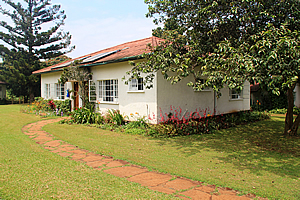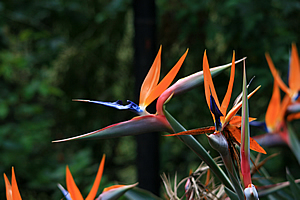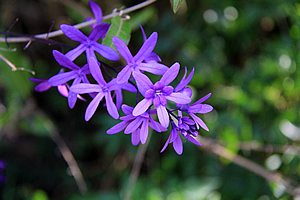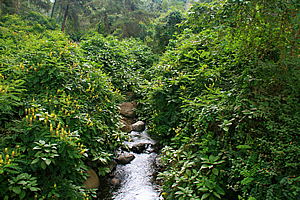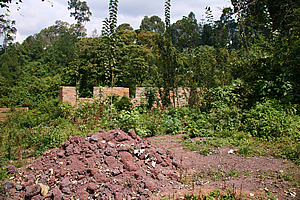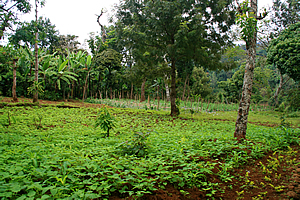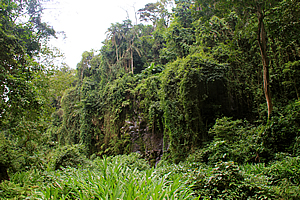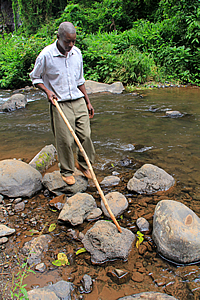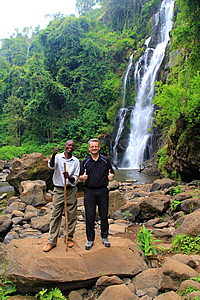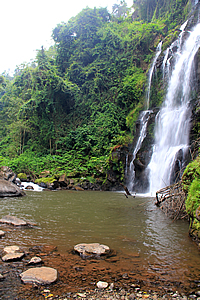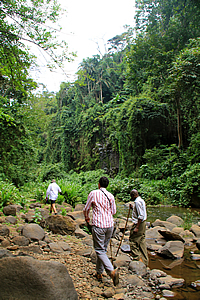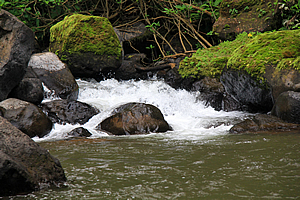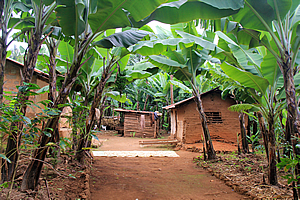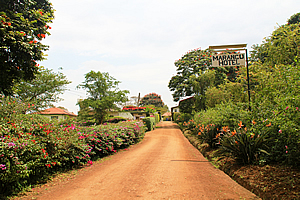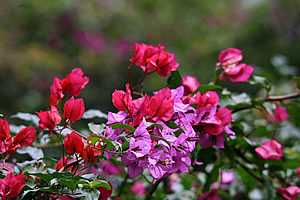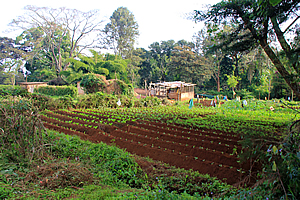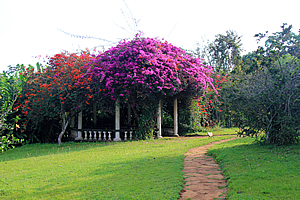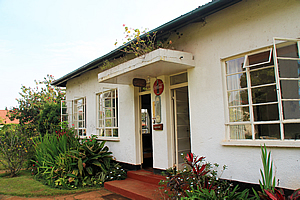|
||||||||||||||||||||||||||||||||||||||||||||
|
||||||||||||||||||||||||||||||||||||||||||||
Home > Treks > Outside Australasia > Mount Kilimanjaro > 2 |
||||||||||||||||||||||||||||||||||||||||||||
|
||||||||||||||||||||||||||||||||||||||||||||
Introduction to today's journeyI think when you've travelled around a lot in Africa, you understand something that many people here don't recognise - the extraordinary power that is Africa at village level - at community level. - Stephen Lewis. Today's journey keeps me in the Marangu Village, exploring the area and discovering a beautiful waterfall. Back at the hotel I am briefed and geared up with my fellow trekkers ready to start the Kilimanjaro climb. Today's JourneyDistance trekked today: 4 kilometres. Total distance trekked to date: 4 kilometres. I WOKE up at about 5:45 with the alarm. It was still dark outside, but I was determined to see the mountain illuminated by the sunrise. I quickly got dressed in the coldness of the morning and walked outside. It was almost 6:00 but there was no sign of light. I looked up. There were no stars. Drat. It was overcast. I walked around to the reception area and looked up the hilly slope towards where I gathered the mountain was. It was overcast in every direction. Looks like I’ll miss seeing the mountain this morning. A security guard approached me and told me it was too early to see the sunrise, so I returned to my room and waited until breakfast, checking my washing, but most of it was still wet, so I hung it out over the railing on my little balcony. Despite the very damp foggy air, I hoped it would dry out today. I returned to my room, and discovered some information about the history of the hotel: The site was originally a coffee farm set up on land purchased from the Marangu tribe in 1907. The original farmhouse still serves as the main building where the reception is located.
Coffee prices around the world declined in the early 1930s, so the owners of the farm supplemented their income by taking in paying guests. By then they were familiar with the mountain so by accident they became one of the first outfitters for organised mountain climbs. Another building was built and it housed another family, the Brice-Bennetts who had travelled by road from Nigeria. The two families built the Marangu Hotel business and its associated climbing operations. The founders have since died, but their children Desmond and Seamus inherited the business which they continue to run to this day. The climbing business is a lot more competitive these days. They survive through to the commitment to the ongoing development of the Marangu area. In an area where the unemployment is around eighty percent, many of the locals here are employed as porters, guides, and hotel workers. Many people have worked here for decades and the most senior guides have been working the mountain for over forty years - since before I was born. The hotel reminded me very much of a commune where I lived in the late 1980s. It had started as a large single storey farmhouse, but was expanded to have another house added to either end of it in the years before my family moved there. It was a large sprawled out house in a particularly scenic and mountainous part of New Zealand. The Marangu Hotel was set up in a very similar fashion. I entered the dining hall at about eight o’clock. I showed my room key to the steward at the door who led me to a table which had my key number on it along with a couple of other key numbers. There was one guy already sitting at the table. I figured if they were sitting us together then perhaps we are going to be in the same group. I introduced myself, and he introduced himself as Gary or the diminutive Gaz as he preferred to call himself. He said he was from New Zealand. Wow, another New Zealander! I mentioned that I was initially from New Zealand myself, but now live in Brisbane. He did too, though at the other end of the city. Sadly though he was living in a part of town where I tend to dare not venture due to its rough reputation. Gaz pointed out his wife who was talking with a couple who had just come down from the mountain yesterday. They had climbed to Gillman’s Point, at the edge of the crater, but because it was snowing, they decided not onto go to the summit. The trek had been extremely tough for them.
His wife Dawn came over and introduced herself. They mentioned they were from Matamata – the location of Hobbiton in the Lord of the Rings movies. They were both very tall and lean by any standards - certainly far too tall to be hobbits so I thought. I instantly got a great rapport with Gary and Dawn. They had arrived here from Australia yesterday to climb the mountain. They had flown the same route as me from Brisbane to Dubai to Nairobi to Kilimanjaro, but without the extra day's stopover I had in Dubai and several days in Kenya. Once the climb is finished, they will return to Brisbane to pack up and move down to Melbourne to start afresh. Once breakfast was finished we returned to our rooms together. They were staying in the room across the path from me, and had heard my arrival last night. I thought I had arrived quietly last night, but obviously not unnoticed. We sat down on their balcony talking about the upcoming trip, and about our lives back home. Dawn was half Maori and spoke with an obvious Maori accent. They were both very funny. Today they wanted to walk up to a local waterfall, and I was keen to join them. We all needed our climbing equipment inspected though, so we decided to wait until after the inspection before leaving. I returned to my room, and noticed the power had gone out. Obviously the generator had overloaded or maybe they were saving diesel. Electricity is apparently quite a rarity here, only available by diesel generators for upmarket places like this, but even here it is only available when absolutely necessary. When I had booked this trip earlier in the year, the trip notes said our gear would be checked upon our arrival at the hotel, and we would be provided with any equipment we didn’t have free of charge. Now mountain trekking equipment is quite bulky, so knowing that equipment would be provided meant I could deliberately leave some things at home. Now there was some equipment that I had to bring. Things like my day pack, gloves, gaiters, woollen hat, walking pole, etc. These were personal items that definitely fitted me. Other things such as a sleeping bag and wind proof jacket weren’t that personal, so I opted to leave some of that stuff at home knowing they would be supplied here.
The inspection lady finally arrived. Ruth was a small woman aged in her sixties with very deeply weathered wrinkled skin and a very stern expression on her face. Despite her stern appearance, she had a very soft voice and a nice manner. Ruth was carrying a clipboard with a list, and started to look at the equipment I had put out on my bed. We went through the list, ticking off each item as she inspected it and quietly nodded. She asked me in rather broken English about the things she couldn’t see. Of all the equipment I had, she seemed very happy with every item. By the end of the inspection she had a small list of things for me to borrow. Ruth beckoned me to follow her. We walked outside passing through the reception courtyard to a dark obscure storage room behind the huge kitchen. Large old wooden shelves lined the walls from floor to ceiling full of all sorts of climbing equipment. How did they manage to accumulate all this stuff? Lost property? Donations from climbers who didn't want to lug their excess clothing around the world now they no longer needed it? We collected a large sack to store the stuff I was leaving behind, a sleeping bag, an anorak, a sunhat and a small water bottle. My three litre camel back was good, but she explained that any water in it will freeze during the final ascent to the summit. The small water bottle will be for wearing against the chest when I climb into sub-zero temperature conditions to prevent from freezing. I signed out all the equipment I needed and returned to my room with the borrowed gear to start packing it all into my backpack. After packing my backpack ready for tomorrow's climb of Kilimanjaro I met Gary and Dawn outside our rooms for a short walk to one of the local waterfalls. I had been testing the big lens out photographing some tiny birds that were pecking at the short bright green grass for tiny insects. They had reddish brown bodies and bright blue beaks. When Dawn appeared the birds fluttered off. She and Gary needed to go and withdraw money from the local bank. Thomas the taxi driver who brought me here from the airport last night had told me that if I wanted to leave the hotel compound, I really should take a guide with me. He said there are guides approved by the hotel, and other guides who say they are approved by the hotel, but are not. The guides that are approved by the hotel will charge about five dollars. Goodness knows what the others would charge recalling my recent experiences in souvenir shops in Kenya.
By now I had learnt not to trust locals here. The entire concept of fair trading was non-existent in this part of the world, so as we approached the gate I became very suspicious. Now I decided that three of us walking together were going to be a big enough crowd to prevent any problems. I was carrying both my cameras, expecting to see a few strange birds potentially necessitating the use of the telephoto lens. No sooner did we reach the sidewalk than Gary began to befriend one of the guides outside. The guide was well presented with an off-white shirt and dark cream trousers and a fairly new pair of boots. I wanted to warn Gaz, but couldn’t work out a way of doing it discreetly. I walked behind them with Dawn walking beside me up the road towards the slope of the mountain which still eluded us. Aleck the guide introduced himself. We walked past the houses of some of the relatively wealthy people who lived up here. These houses were quite impressive. They were well hidden though behind huge security gates and fences cutting their owners off from the real world out here so it seemed. We noticed a jackfruit tree. This was by far the largest I had ever seen before. Dawn and I were talking about our lives back home, and what we did. By now Gary was quite friendly with our guide Aleck, so I decided to go with the flow accepting we will be hit quite hard financially again at the end of the short walk up to the bank.
We finally reached the bank. Two armed guards were standing outside. They started to approach us, but Aleck reassured them. Dawn went to the ATM machine, but couldn’t get money out, so they both went into the bank leaving me outside with Aleck and the guards armed with their AK-47s and me equally armed with my cameras. Aleck told me he was one of the many porters who worked on the mountain. He would go up about twice a month. Most fit men living here similarly worked as porters. For most this was their only source of income. There was otherwise very little work here. During his time off, Aleck would keep himself going by conducting the small village tours as he was doing now. The porter work on the mountain was very sought after for the local Chugga people. Unemployment around this part of Tanzania was around eighty percent. No wonder they had armed guards at the bank. Finally Gaz and Dawn returned having successfully withdrawn the shillings they needed. I was relieved having done the multiple bank thing in the grim darkness of Moshe last night. At least they had daylight, two armed guards and a guide. I on the other hand only had a taxi driver and the total darkness of night in an alley. Now I’ve just found out that on top of that it was a dark alley in the middle of a large town with an eighty percent unemployment rate. We left the bank and continued walking up the road. I asked Gary what we were doing, and he said Aleck was taking us through the village to the waterfall he wanted to see. Gosh, there’s more money gone I thought. This was potentially turning out to be a very expensive walk. We diverted up a dirt road running steeply uphill through a small shanty market area. The market quickly gave way to forest sheltering the tiny homes of the local porters. This reminded me of some of the rural villages I had seen in Central Vietnam. We followed a forest road around the hill until reaching a school. A couple of vans full of children passed us entering the school grounds. The kids were singing and yahooing as if they had won Lotto. They were certainly a lot noisier and happy than the children in the schools in any other country I had been to. Sadly it seems there is happiness in poverty.
We continued further up the hill, passing a large outdoor seated area set up as a church. No one was there yet, but it was obvious some sort of a service will be starting soon, or perhaps it has already happened. The terrain continued to roughen as we continued walking through the village. I already felt like I was on the mountain. In fact I was. This was about fourteen hundred metres up the lower slopes of Mount Kilimanjaro, the southern extreme of where part of the rift valley has torn apart letting a huge amount of magma through to the surface over the past couple of million years. At this stage I had no appreciation of just how big the mountain was yet. After all the summit hadn’t revealed itself to me since I had flown past it yesterday. The houses nestled here were real shanties with rusting corrugated iron roofing over mud brick houses. Every house had its own yard with bananas and vegetables aplenty enough to sustain the families that lived in them. We finally reached a wooden small hut at the edge of a deep gully. One man was sitting in the tiny hut sharpening a small machete. The hut marked the entrance to the waterfall. Our guide approached him and quite gleefully announced that we needed to pay five dollars each to go to the waterfall. Dawn and I exchanged glances – Africa - the land of the unconscionable upsell. Anyway the machete looked very sharp so we paid up without protest. The guard quickly counted the money and with the sharp end of his machete he pointed us in the direction of the track, a small overgrown entrance through the thick undergrowth. We turned left and followed the slightly overgrown narrow trail steeply down the gully. Soon we reached a hairpin bend with some big steps before heading upstream now that we could hear the stream below. We were now entering thick undergrowth typical of a damp gully microclimate. Here the view was mostly concealed, but when we did see through the foliage, I could see a moss covered cliff on the other side. I was falling a little behind both Gary and Dawn. They were both very fit thanks to their work back in Brisbane as arborists. Such an occupation required a high level of fitness. Aleck was obviously very fit as well. On the other hand my fitness wasn’t the best. I had put my back out a little a few weeks ago forcing me to stop training for a while. Additionally the weight of my cameras was slowing me down. For a few brief moments I started to wonder whether I would be able to cope with climbing the mountain. If I was struggling here on a small track down to the waterfall, then how would I cope with the mountain?
We continued following the steep damp trail for a few more minutes before suddenly reaching the small river. To our right stood a derelict hut nestled in amongst the thick forest. To our left the crystal clear stream bubbled over the grey boulders. The hut was clad only in well-spaced small branches, and it had a fairly fresh thatched roof of dried out banana leaves. We followed a trail through the grassy bank for a few metres before seeing the magnificent waterfall. It was one of the prettiest I have ever seen. The water plunged some thirty metres down an almost vertical rock face which would have perhaps been the end of an ancient lava flow. The water cascaded into a large pool at the bottom, where to the left a smaller stream tumbled into it without any waterfall. Combined the streams came out of the pool and gently cascaded down the steep gully. The waterfall and gully were covered in a mixture of broadleaf climbing vegetation and ferns. There were quite a few ferns growing in between the boulders on the flat. No doubt they would cling for dear life when the stream floods. The pool itself was a little turbid but otherwise perfectly inviting apart from a small dead tree with no leaves that had no doubt been washed over the waterfall during a flood a few years ago.
|
||||||||||||||||||||||||||||||||||||||||||||
With the guide at the waterfall |
The sound of the water tumbling down the waterfall was very serene, mingling in well with the calls of the strange birds in the trees unseen. It made for an extremely peaceful setting, the sort of place you would want to come for a few days’ silent retreat.
In front of the pool was a large flat boulder, where we took turns getting out photos taken. I gave Dawn a quick lesson on using my camera, and framing a good shot. She actually did a very good job especially considering they only had a credit card camera between them.
Waterfall plunging into pool |
Returning down the gorge |
I posed with Aleck, still looking very slick with my brand new boots which I had bought only a few weeks ago. They looked new now having only been worn on this trip, but I wondered what state they will be after I have worn them for the next five days up the mountain. I know from past experience that volcanoes wreak havoc on boots, and they always seem to come out second best after hiking through the extremely rough gritty young rocks typical of volcanic terrain.
Side stream running into pool opposite the waterfall |
Aleck used his walking pole to turn over a couple of rocks, looking for fish beneath them. Fish tend to go upstream, he said, but the waterfall prevents them from going any further, so there should be a concentration of small fish here. We saw a couple of very small ones, but nothing too interesting.
We left the waterfall and started the trek up the steep track. Although I was weighed down with my two camera bags, I easily managed to keep up this time. Thankfully I won’t be too much of a hindrance in the uphill sections of the climb.
Once back through the entrance of the waterfall track, we followed another road heading back towards the hotel. We passed through another part of the village, where most of the derelict houses were surrounded by very healthy banana plants standing three or four metres high with vegetables growing beneath them.
Banana trees amongst the village |
Now banana trees do attract snakes, and we had to go very careful. Now I never saw any snakes on the way back to the hotel, but the others saw a rather dangerous one very close by. I think it would have been a deadly black mamba.
We walked through the avenue of banana trees occasionally greeted by children who seemed so happy to see these strange pale foreigners walking through their village. They would frantically wave to us from outside their homes.
It was not long afterwards when we reached a long high concrete wall. Aleck told us this was the wall of the hotel, so we must be close now.
Entrance of the Marangu Hotel |
We finally reached the entrance of the hotel ready to pay Aleck the agreed five dollars, but no, he wanted five dollars from each of us. Grrr – Gary’s naivety this morning had well and truly opened us up for getting ripped off. I made a mental note to get any future agreements in Africa in advance, in writing. Clearly this was the land of the unconscionable upsell!
After paying up, we walked back up the driveway through the incredibly colourful flowering bushes. No doubt the rainfall was high here. Thick cloud still shrouded the view of the mountain, so there wasn’t anything to see.
|
Once back in the safety of the hotel, we were rather hungry, so we went to a large outdoor seated area to order lunch. We all decided to go for a steak and chips with salad. Clearly I was deviating from the local cuisine, but given what I had seen in Masai Mara, I just wasn’t game to go with what would pass as being local diet.
The food was amazing though. The portions were very large. Perhaps this was because the much larger African people here have a bigger appetite than us Caucasians to maintain their amazing physique. Gary also had a Coca Cola, which curiously in his words "tasted like shit". Normally he really likes his coke, but he had no idea why it tasted so revolting. Later this evening we would find out why.
|
The three of us just relaxed eating lunch. Then Gary started talking about the locals and how unfriendly they seemed. They all seemed to have hidden agendas around getting our money. Honestly I couldn’t agree more.
He mentioned that they had travelled between Kilimanjaro airport and here during the day. From their taxi (which was even more expensive than mine) they had seem how rough people lived here, describing the huts they lived in. It didn’t sound too impoverished to me though – certainly not compared to Cambodia.
Then they mentioned that most of the other tourists here didn’t seem overly friendly either, but I was an exception – they had already decided I was the friendliest person they had met in their short time here. I was quite taken aback by that. Not many people mention that I’m friendlier than most others, but then again we were all New Zealanders, so we had the same cultural background. As they say birds of a feather flock together.
Flowers in the hotel grounds |
After lunch, I sat around in the gardens photographing the amazing flowering plants and the tiny birds that drank the nectar from the large flowers. The grounds were immaculate. Once rested, I walked around the gardens, firstly passing my room where next door to me were two rather noisy people who appeared to be from India but had distinctly North American accents who had just arrived, but I just missed them. The power was still out.
I walked around to the back of the hotel buildings to a large vegetable garden. No doubt all our fresh food came from here. I have never stayed in a hotel before where the food was grown on site. There were a few hanging rags acting as crude scarecrows, and a few people working in the rows of vegetables. There were plants of all sizes, indicating good planning and a steady supply.
Hotel vegetable garden |
I returned to my room to see whether my washing was dry. Thankfully all of it had dried apart from one of the thicker shirts. I now had enough clothing to wear up the mountain. The power suddenly came back on, so I started charging one of the camera batteries. I had to keep them all as full as possible in case there are more major power outages before we leave tomorrow.
I sat down on one of the rickety chairs on the porch to rest. Then the two Indian guys came out. I introduced myself, and they introduced themselves. The older one was Mark and the younger one was his son Jonathan – or Jono as he preferred to be called.
Colourful gazebo |
Mark had the deep lines and strong features all over his face typical of someone who spends too much time outdoors. Jono had a rather young looking short black beard which I imagined was his first attempt at growing one. They spoke with strong Canadian accents and told me they were from Toronto, although Mark had grown up in India. They were here on a family trip having toured around the Serengeti and were now about to head up the mountain.
We quickly realised that we were all in the same group, so I told them they should join me out in the outdoor dining area soon where we will hopefully meet Gary and Dawn. Now Jono wanted a bath, and they both needed to unpack, so they returned into their room.
Hotel rooms |
Once they were back in their room, I decided to wander back to the outdoor dining area where Gary and Dawn were relaxing. We talked for another half hour before Mark and Jono joined us. Then a young lady sitting nearby came over and introduced herself. She was Ashley, a school teacher from New York. Within a couple of minutes we realised she was also part of our group.
There was a circle of chairs further up the hill where a group of about ten people who had successfully returned from their epic five days on the mountain. They were assembled seated in a circle on some of the garden chairs saying their goodbyes to their guides and porters. They were singing the Kilimanjaro song. They had completed the hike. We were yet to start.
How I envied them – lucky sods!
| Home | Photography | Diary | Travels | Treks | |
© 2001-2020 walkaboutjeff.com - Copyright - Disclaimer - Who is Walkabout Jeff? |

